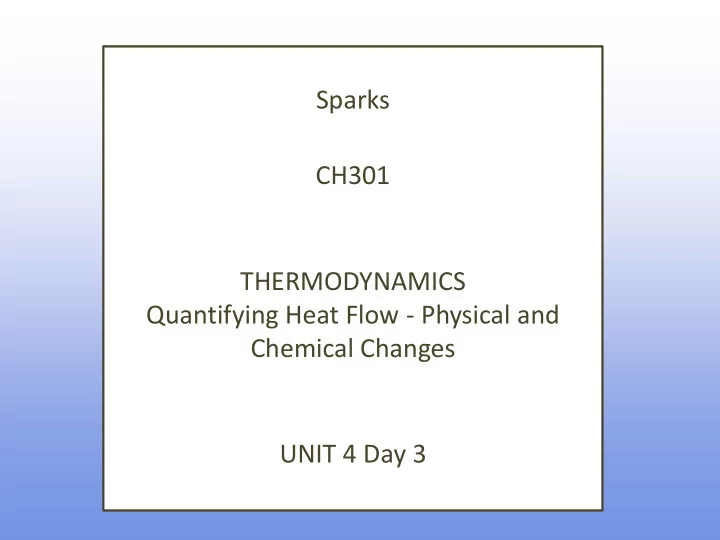

Sparks CH301 THERMODYNAMICS Quantifying Heat Flow - Physical and Chemical Changes UNIT 4 Day 3
Review: Energy Definitions What is Energy? Potential Energy (PE) energy due to position or composition Kinetic Energy (KE) energy of the motion of an object or particle Units: J
How does Energy move? Heat (q) transfer of energy from a hotter body to a colder body (NOTE: This is not temperature) Work (w) transfer of energy via applied force over distance Units: J
Heating Curve Describes relationship between heat and temperature during some physical changes. Temperature [°C] 100 0 Heat
Demonstration Ice Water Water Boiling Water 120 °C 120 °C 120 °C
POLL: iClicker Question Think about the two systems in which the temperature remains constant. In these cases the thermal energy is being transferred from the hot plate A. To the surroundings, bypassing the water/beaker system B. To the water/beaker system in the form of thermal energy (kinetic energy) C. To the water/beaker system in the form of potential energy D. There is no energy transfer. If there is no change in temperature, then there is no flow of heat energy.
Adding in the Numbers • Heat capacity (C): heat absorbed relative to the temperature change. Possible units: J / ⁰C • Specific Heat or Specific Heat Capacity (C s ): the amount of heat required to raise the temperature of 1.00 g of a substance by 1°C. • Molar Heat Capacity (C m )
Substance A Substance B Temperature Temperature Heat added Heat added Which substance has the higher specific heat when in the liquid phase? (The temperature and heat scales are the same for the two graphs.) A. Substance A B. Substance B
POLL: iClicker Question • A liquid substance has a heat capacity of 1.5 J/g°C. Is heat is absorbed or given off when a 50 g sample of the liquid goes from 60°C to 40°C? No changes in phase occur. A. absorbed B. given off
POLL: iClicker Question • A liquid substance has a heat capacity of 1.5 J/g°C. What is the magnitude of the heat change in J when a 50 g sample of the liquid goes from 60°C to 40°C? No changes in phase occur. (Note: we are just going for the magnitude, not the sign. Enter a positive value.)
Adding in the Numbers • Heat of Vaporization: Δ H vap : Heat needed to vaporize a specific amount of a substance • Heat of Fusion, Δ H fus : Heat needed to melt a specific amount of a substance
Thought Question! Which are appropriate units for Δ H vap ? A. J/(g ⁰ C) B. J/ ⁰ C C. J/g D. g/J ⁰ C
H 2 O • Specific Heat (J/gºC) H 2 O (l) = 4.18 H 2 O (s) = 2.09 H 2 O (g) = 2.03 • Heat of fusion 334 J/g • Heat of vaporization: 2260 J/g
Heating Curve
Heating Curve Calculation • How much energy is required to heat 100 g liquid water from 60 ⁰ C to steam at 100 ⁰ C?
Enthalpy Enthalpy change = Δ H = q p The enthalpy change, ∆H, is the quantity of heat transferred into or out of a system as it undergoes a chemical or a physical change at constant pressure.
POLL: iClicker Question • For which reaction, carried out at constant pressure, would ∆H = ∆E? Remember, ∆E = q + w A. 4Fe(s) + 3O 2 (g) 2Fe 2 O 3 (s) B. N 2 (g) + O 2 (g) 2NO(g) C. 2NO (g) + O 2(g) 2NO 2(g)
• Question: What is the difference between ∆H and ∆U?
Calorimetry An experimental technique to measure the energy change associated with a chemical or a physical process.
Calorimetry Calculations • The calorimeter will contain a liquid. • The system consists of the reaction in question. The surroundings consist of the calorimeter and liquid. • Any heat released by a process occurring inside the calorimeter is absorbed by the calorimeter AND the liquid.
Calorimetry A Coffee Cup calorimeter measures the transfer of heat at constant pressure. (q p = Δ H) A Bomb calorimeter measures the transfer of heat at constant volume. (q v )
Demonstration Dissolve CaCl 2 in water
POLL: iClicker Question Look at the following physical change observed in the calorimeter demonstration: CaCl 2(s) Ca 2+ (aq) + 2Cl - (aq) Which is lower in energy? a) Products b)Reactants
Calorimetry Example 1 • To perform the following reaction, we add 0.10 mole of ICl to a bomb calorimeter whose heat capacity is 1.14 kJ/ o C. The temperature of 5000 g of water rose from 25.00 o C to 25.081 o C. Determine ∆E for the reaction in kJ/mol. ICl(g) ½ I 2 (s) + ½ Cl 2 (g)
What we’ve learned so far: Our next topics: • Internal E and Enthalpy • Internal E and Enthalpy – ΔE = q + w – Calculating ΔH • From known reactions – + q and – q, +w and – w • From heats of formation – ΔH = q p • From bond energies – The relationship between ΔE and ΔH – Determining enthalpy experimentally: calorimetry
Learning Outcomes Calculate change in enthalpy for physical change in T and Phase Change Understand the concept of heat capacity, specific heat capacity and molar heat capacity Explain the difference between coffee cup calorimeter and bomb type calorimeter Understand the concept of change in enthalpy Calculate change in enthalpy, ΔH, and change in internal energy, ΔU, based on raw calorimeter data Calculate q for various processes
Recommend
More recommend